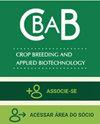面包小麦穗肥力指数的QTL定位
IF 1.1
4区 农林科学
Q2 Agricultural and Biological Sciences
引用次数: 1
摘要
穗肥力指数(SF)是一种在成熟时易于测量的性状,与单位面积粒数密切相关。以80个重组自交系(RIL)的双亲本(Baguette 10 × Klein chaj本文章由计算机程序翻译,如有差异,请以英文原文为准。
QTL mapping of spike fertility index in bread wheat
: Spike fertility index (SF) is a trait easily measured at maturity and strongly associated with the number of grains per unit area. In order to identify genomic regions involved in SF control, a biparental (Baguette 10 × Klein Chajá) population of 80 recombinant inbred lines (RIL) was used. Seven field trails were conducted to determine the SF BLUP value per RIL. RILs were genotyped using a commercial chip (Axiom® 35K SNP Wheat Breeder’s Array, Affimetrix). A linkage map was constructed with 857 SNP markers, and SF QTL mapping was performed. The narrow-sense heritability of SF was 0.89. Three genomic regions (QTL) associated with SF were found on chromosomes 2D, 4A, and 7A. The proportion of genetic variation explained by these three QTL was 32%, with no significant epistatic interaction between QTL.
求助全文
通过发布文献求助,成功后即可免费获取论文全文。
去求助
来源期刊
CiteScore
2.40
自引率
13.30%
发文量
25
审稿时长
6-12 weeks
期刊介绍:
The CBAB – CROP BREEDING AND APPLIED BIOTECHNOLOGY (ISSN 1984-7033) – is the official quarterly journal of the Brazilian Society of Plant Breeding, abbreviated CROP BREED APPL BIOTECHNOL.
It publishes original scientific articles, which contribute to the scientific and technological development of plant breeding and agriculture. Articles should be to do with basic and applied research on improvement of perennial and annual plants, within the fields of genetics, conservation of germplasm, biotechnology, genomics, cytogenetics, experimental statistics, seeds, food quality, biotic and abiotic stress, and correlated areas. The article must be unpublished. Simultaneous submitting to another periodical is ruled out. Authors are held solely responsible for the opinions and ideas expressed, which do not necessarily reflect the view of the Editorial board. However, the Editorial board reserves the right to suggest or ask for any modifications required. The journal adopts the Ithenticate software for identification of plagiarism. Complete or partial reproduction of articles is permitted, provided the source is cited. All content of the journal, except where identified, is licensed under a Creative Commons attribution-type BY. All articles are published free of charge. This is an open access journal.

 求助内容:
求助内容: 应助结果提醒方式:
应助结果提醒方式:


